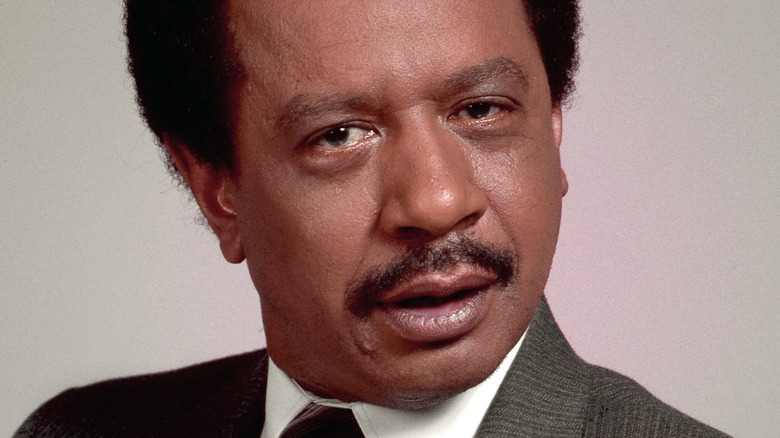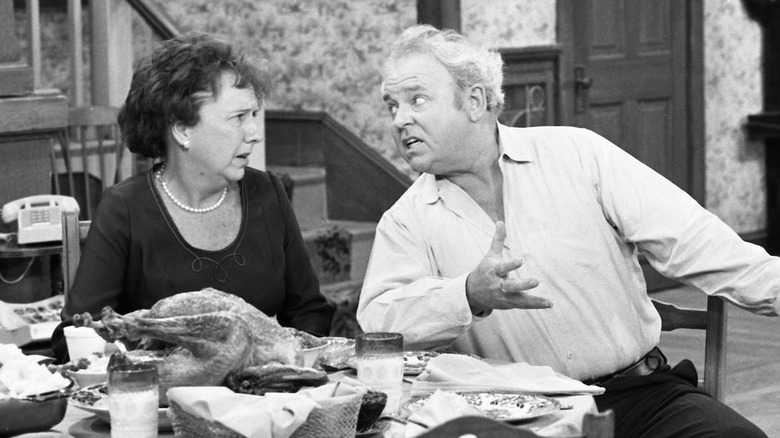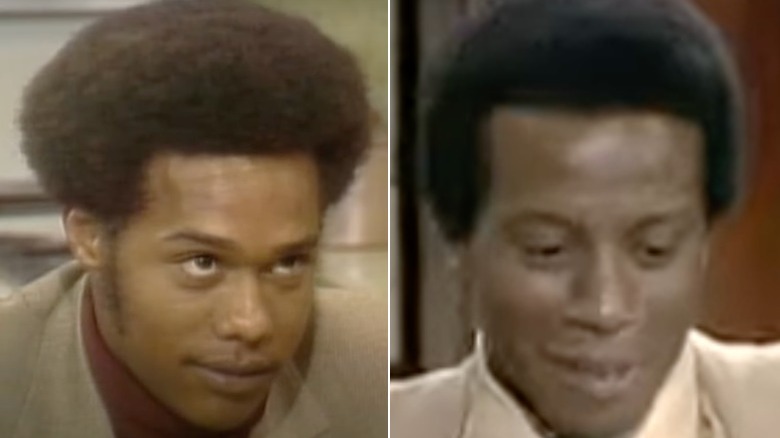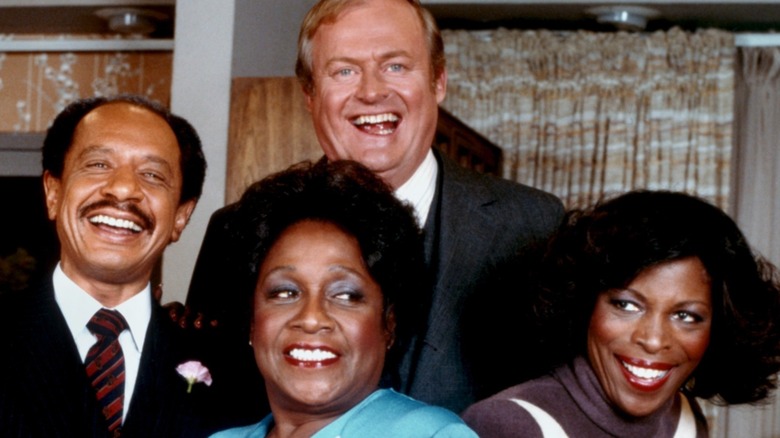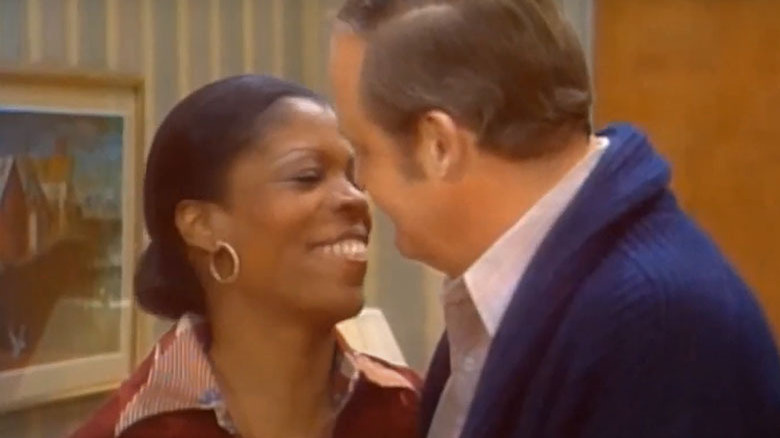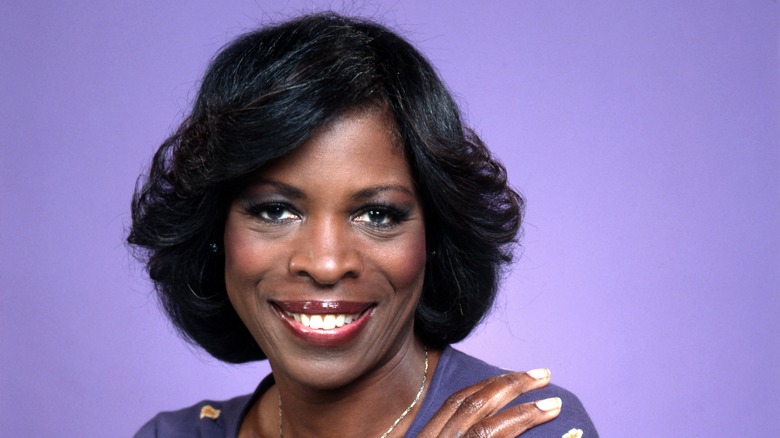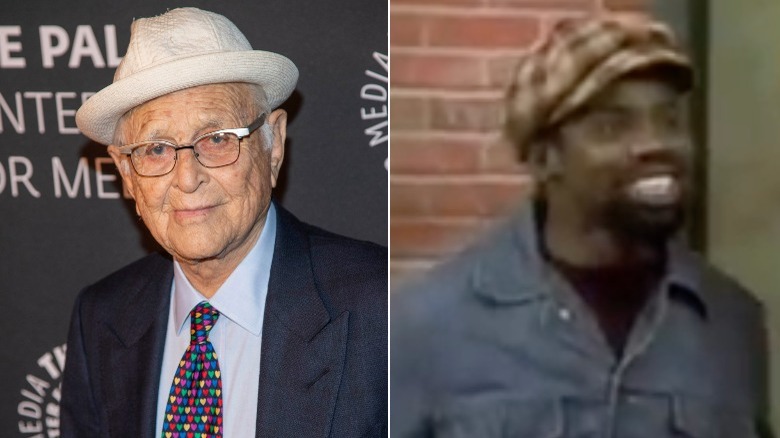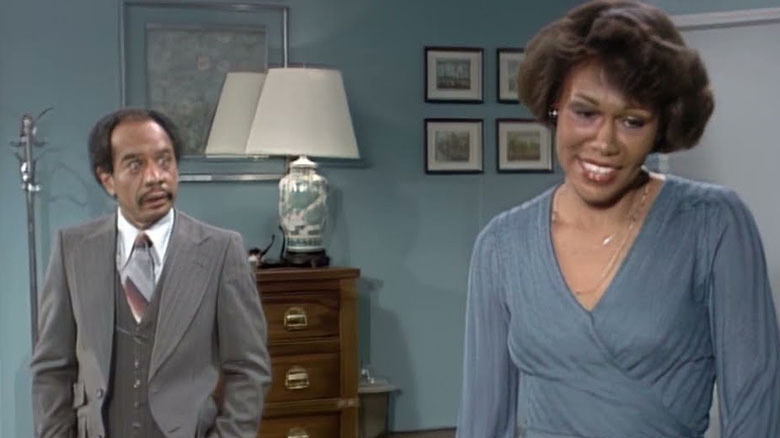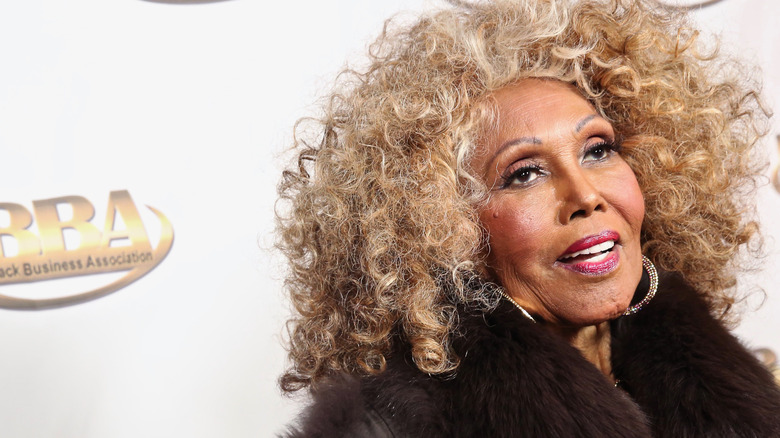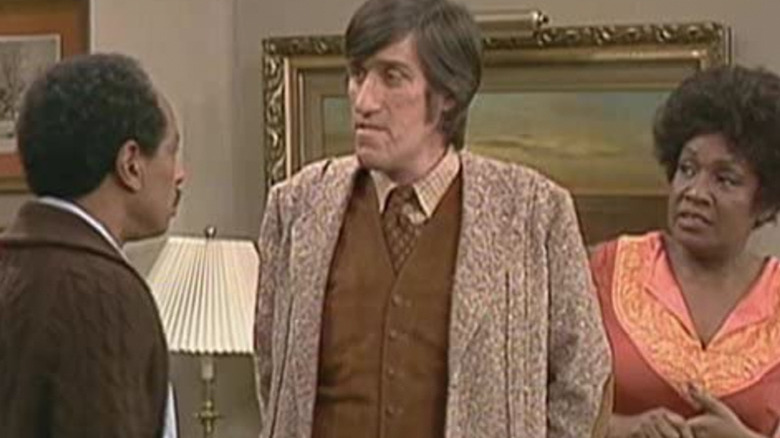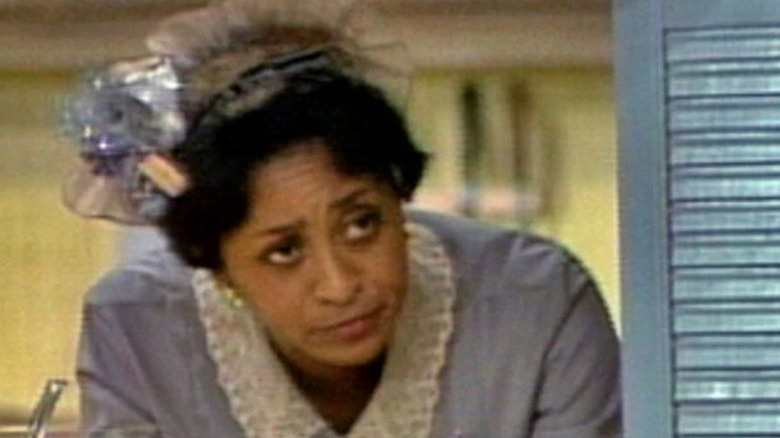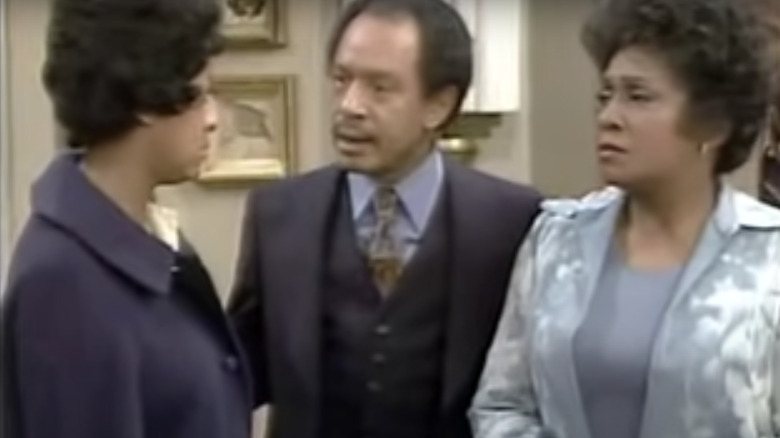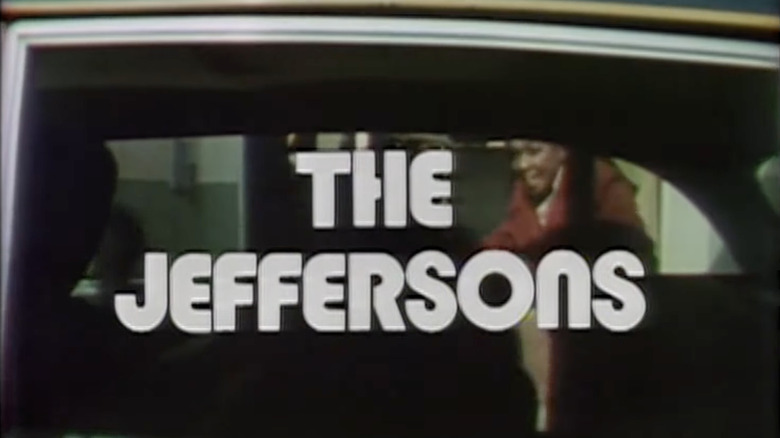The Jeffersons: The True Story Behind One Of TV's Most Iconic Shows
Spanning 253 episodes from 1975 to 1985 and developed by TV legend Norman Lear, "The Jeffersons" was among the most popular shows of its day, depicting the life of a well-to-do Black family in a high-rise apartment building on New York's Upper East Side. Created by Don Nicholl, Michael Ross, and Bernie West, and starring Sherman Hemsley and Isabel Sanford as George and Louise (Weezy) Jefferson, the show arrived on the heels of "Good Times," another successful Lear-developed show that portrayed the lives of a Black family, and found a following as a spinoff of Lear's classic "All in the Family."
This was something of a golden era for sitcoms about Black families, with "What's Happening!!" (based partially on "Good Times" co-creator Eric Monte's film "Cooley High") also running concurrently with "The Jeffersons" from 1976-1979, and "The Jeffersons" was among the most successful. Even after all these years, though, there's still plenty about this long-running hit series that even the biggest fans may not know.
Following All in the Family
In "All in the Family," the Jeffersons were introduced as neighbors of Archie and Edith Bunker, as well as targets of the bigoted Archie's barbs. Though the outspoken George was, in many ways, as disagreeable as Archie, he was a savvier businessman, and his dry-cleaning business grew into a small chain whose success spurred the family's memorable move to a "deluxe apartment in the sky" in Manhattan.
Four spinoffs in all emerged from "All in the Family" during its lengthy run, with "The Jeffersons" being the most successful. "Maude" (featuring Bea Arthur) began in 1972 and ran for six seasons; "The Jeffersons" ran for 11; "Archie Bunker's Place" lasted for four; and "Gloria" (featuring Sally Struthers) ran for one. Mike Evans, who as son Lionel was the first Jefferson to appear on television, co-created "Good Times," which was loosely spun off from "Maude," and featured Maude's former maid Florida Evans (Esther Rolle).
Mike Evans' early demands
Mike Evans (above left) was the first Jefferson to appear on "All in the Family" and co-created "Good Times." Given his behind-the-scenes involvement, it's perhaps understandable that he felt he felt he deserved more screen time than Sherman Hemsley and Isabel Sanford, whom Evans saw as cast members on "his show." According to Jimmie Walker, who played J.J. on "Good Times," Evans made this clear to Lear at a holiday party, threatening to walk if his wishes weren't fulfilled. Lear, unmoved by Evans' demand, turned to his Tandem Productions accountant (and future chairperson of Walt Disney Studios), Alan Horn, to ask if there would be any issue releasing Evans from his contract. Horn confirmed that it was in no way a problem, and with that, Evans was out. Another actor, Damon Evans (above right, no relation), took over the role of Lionel until 1979, when Mike returned, and remained a regular through 1981 (though he appeared sporadically until 1985).
Sherman Hemsley was 21 years younger than Isabel Sanford
Both Isabel Sanford and Sherman Hemsley started in the theater, and made Broadway debuts prior to appearing on "All in the Family." According to the African-American Registry, Isabel Sanford was working as a data processor by day when she was cast in the 1965 Broadway production of James Baldwin's "The Amen Corner." Two years later, producer-director Stanley Kramer cast Sanford in his Academy Award-winning film "Guess Who's Coming to Dinner?" as Tillie, the housekeeper of Katharine Hepburn and Spencer Tracy's characters. The Registry points out that Hemsley worked as a post office clerk before joining The Negro Ensemble Company (NEC) and making his professional acting debut in the Broadway production of Ossie Davis' Tony Award-winning musical "Purlie." It was that show's subsequent one-year tour which kept Hemsley from appearing prior to Mike Evans in "All in the Family," though Hemsley was Lear's first choice for the role of George. And while Isabel Sanford was 21 years older than Hemsley when cast, it seemingly mattered little to fans, who didn't mind (or notice) the difference and accepted them as the "happy couple."
A groundbreaking couple
The stigma around the idea of mixed-race couples was still a television taboo when "The Jeffersons" premiered; after all, this wasn't far removed from 1967, when the Supreme Court (in Loving v. Virginia) struck down laws banning interracial marriage and the aforementioned "Guess Who's Coming To Dinner?" was released. Representation in the movies hasn't really become more prevalent since, according to Syracuse University law professor Kevin Noble Maillard, whose 2017 New York Times article noted, "The census finds record rates of mixed marriages and relationships, but few of these couples or their children make it to the screen. We may see and know mixed couples and families, but the anecdotal does not translate into collective visibility."
TV's record is somewhat different. In 1968, there was a memorable kiss between William Shatner and the late Nichelle Nichols on "Star Trek," and, in the '70s, "The Jeffersons" brought us Helen and Tom Willis, played by Franklin Cover and Roxie Roker. The Willises were a couple in the Jeffersons' building with two adult children named Allan and Jenny. Initially unable to stomach the Willis' relationship, George refers to the pair as "chocolate and vanilla" and "zebras," but eventually becomes good friends with Tom. Jenny marries Lionel and the two have a child, only to separate and divorce in Season 8.
Lear's fears
According to his memoir, to ensure that Roxie Roker would be prepared for the idea of playing one half of an interracial couple, Norman Lear sat Roker down, explained the relationship, and assured Roker that it would be "as real as any other on TV." Lear warned her that she would likely encounter some resistance from audiences. He needn't have bothered. As soon as he mentioned it, Lear recounts that Roker produced a wedding photo. "There stood Roxie, the bride, with Seymour Kravitz, her white Jewish groom." Kravitz and Roker had married in 1962 and had one child, a son named Leonard (who went on to become rocker Lenny Kravitz), before divorcing in 1985. Roker (who was second cousins with "Today" show personality and weather presenter Al Roker) passed away in 1995; Seymour Kravitz died ten years later. Franklin Cover, who played Roker's TV husband Tom, was recalled by Marla Gibbs as "a hoot" who never had the opportunity to be quite as funny as he was offscreen.
Allegations of theft
Eric Monte (above, right), who co-created "Good Times" with Mike Evans, sued Norman Lear (above, left), who, he claimed, had stolen his ideas for "The Jeffersons" and other shows, including "Sanford and Son" (which was based on a similarly themed British television program, "Steptoe and Son"). Monte's idea was that "Sanford" should be cast with Black actors and feature comedian Redd Foxx, of whom Lear apparently knew nothing. Lear, Monte claimed in an interview with the Philadelphia Inquirer, was comfortable depicting Black Americans in stereotypical ways, and felt that audiences would never buy George's bigoted attitude toward white people. Monte was eventually offered a million-dollar settlement, and according to Monte, was blackballed from the industry after creating the modestly successful "What's Happening!!" (based partly on his 1975 film "Cooley High"). Lear went on to receive numerous awards, including five Emmys, the National Medal of Arts, and a Kennedy Center Honor, and was inducted into the Television Academy Hall of Fame.
More groundbreaking representation
Norman Lear introduced several prominent LGBTQ characters to television, starting with a gay couple in the short-lived series "Hot l Baltimore" (whose incredible cast featured James Cromwell, Richard Masur, Al Freeman Jr., Bernie Kopell, Conchata Ferrell, Dick Van Patten, and Charlotte Rae). On Season 4, Episode 3 of "The Jeffersons," "Once a Friend," George's old Navy friend Eddie pays a visit, surprising George with a minor detail: Eddie is now Edie, having undergone sex reassignment surgery. According to The New York Times, Edie (played by Veronica Redd) was the first transgender character to appear on an American sitcom. This being the '70s, the seriousness (and how well the humor has aged) only goes so far: George is initially repulsed by Edie's decision, and makes a series of transphobic remarks; also, confused by Edie's name, Louise comes to believe she and George are having an affair.
The story behind the theme song
In one of the more delightful behind-the-scenes subplots of Norman Lear's television dynasty, the prodigiously talented Ja'net DuBois approached Lear and asked if she could write music for one of his shows. According to DuBois, Lear agreed to hear her pitch, telling her only that his new show involved a man who ran a dry cleaning business. When DuBois returned with her song, Lear was dumbstruck: how could she have known the show was about an upwardly mobile couple moving to the Upper East Side? In fact, DuBois just wrote what she knew. Her dream had always been to move her mother to a penthouse on the East Side of Manhattan, and the lyrics reflected that. The song, "Movin' On Up," co-written with Jeff "Be My Baby" Barry, and performed by DuBois and Oren Waters with a 35-piece gospel choir, became one of the most enduring themes of its time.
Paul Benedict's lifesaving diagnosis
Like Sherman Hemsley and Isabel Sanford, actor Paul Benedict, who played the Jeffersons' neighbor Harry Bentley, got his start in the theater. Having grown up in Boston, Benedict attended Suffolk University and began acting in the '60s with the Theatre Company of Boston (where he performed with Robert De Niro, Dustin Hoffman, and Al Pacino). Benedict was known partly for his distinctive facial features, including a prominent jaw. It turns out there was a reason for this — and it could have made Benedict's life a lot worse.
According to the L.A. Times' obituary of Benedict and Rick Mitz's "The Great TV Sitcom Book," prior to "The Jeffersons," when Benedict was performing in a play, an endocrinologist approached him afterwards and asked him to come in for tests. Benedict's issues, which had plagued him since childhood, were partly attributed to acromegaly, a pituitary disorder. Subsequent treatment prevented the disease from spreading while Benedict continued to act, and Benedict would go on to use his features for comic effect.
Marla Gibbs didn't give up her day job
Before she landed the role of Florence, the Jeffersons' maid, Marla Gibbs had been working as a flight reservation clerk for United Airlines for 11 years — but getting the part didn't mean the end of her time with United. In fact, she held onto the job for two years after she began work on "The Jeffersons."
Gibbs told The Washington Post that when the series was being taped, she'd leave the studio at 5:30 pm, then go to United, where she worked until 11 at night. In a Q&A with The Hollywood Reporter, Gibbs credited producer Bernie West with convincing her to leave United by offering to cover her extra expenses. She recounted in the interview that West asked if she still had the United job. "I said, 'Yeah.' He said, 'Aren't you tired?' I said, 'No.' He said, 'Would you take a leave?' I said, 'If you pay me.' So I took a 90-day leave from United." Gibbs never looked back, and went on to a successful career that included a leading role in another successful sitcom, "227."
A willingness to address thorny themes
While "The Jeffersons" was first and foremost a sitcom, it dealt with a number of subjects that were not regularly tackled by the genre. In Season 2, Episode 18, George and Louise suspect something's wrong with Florence after she cleans their apartment without griping, takes a taxi to work, kisses Bentley, hands Louise one of her prized possessions, randomly attempts to call an uncle she hasn't spoken to in 20 years, and tells them she's heading to the top of the Empire State Building. Louise discovers a strange letter ("Dear Mrs. Jefferson, Thank you for everything. Goodbye. Love, Florence") that compounds their concern. George, Lionel, and Louise confront Florence, and remind her how much she's loved. ("You're not just a maid," Lionel tells her. "You're one of the family," to which Florence replies, "Lord, I thought Black folks only heard that one in white homes.") According to BET, it was one of the first TV episodes to address suicide.
If you or anyone you know is struggling with addiction issues, help is available. Visit the Substance Abuse and Mental Health Services Administration website or contact SAMHSA's National Helpline at 1-800-662-HELP (4357).
An awards season favorite
Among a uniformly excellent cast, the only "Jeffersons" actor to win a Primetime Emmy was Isabel Sanford, in 1981. Nominated seven times overall for her work on the show, Sanford was the first Black woman to win an Emmy for Best Actress in a Comedy Series. Marla Gibbs was nominated six times and Sherman Hemsley once, but neither took home the award. (The other Emmy the show won was a technical award for tape editing — props to Larry Harris and the editing department at CBS.)
"The Jeffersons" also received Golden Globe Award nominations in 1977, 1978, 1983, and 1984, all for Sanford; in 1985, the show was nominated, along with Sanford, Gibbs, and Hemsley. The show was also a nominee for the Humanitas Prize and received a WGA Award nomination (for "Once a Friend") in 1978, and won two NAACP Image Awards in 1982, for Hemsley and Gibbs.
The Jeffersons had no proper series finale
Eleven seasons in, "The Jeffersons" was canceled — a move that seemed to take the cast by surprise, according to BET; though the show had been falling in the ratings, bouncing from No. 3 in Season 8 to No. 50 in Season 11, it wasn't until after the July 2, 1985 episode "Red Robins" that news trickled out. Sanford apparently learned about it from a cousin, who had read it in a tabloid, while Hemsley read it in the newspaper.
The decision felt like a slap in the face, according to Sanford in an interview with the Archive of American Television; as with other long-running shows of the era (i.e. "The Mary Tyler Moore Show" and "M*A*S*H"), there should have been a more fitting finale, Sanford felt. But the show's legacy has been long since cemented through its ardent fanbase. It received nine TV Land nominations between 2003 and 2008 (winning one, for "Favorite Cantankerous Couple") and it continues to live on — and find new generations of fans — through streaming platforms.
